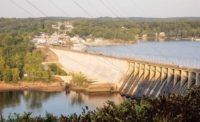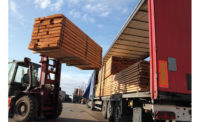The Lake of the Ozarks stretches for more than 54,000 acres in southern Missouri. The Bagnell Dam, which created the lake and several new waterways in 1931, holds back 600 billion gallons of water from the Osage River. Bagnell is the largest privately funded dam in the U.S. This hydroelectric dam’s eight waterwheel turbines generate 722,000-MWh of renewable electricity per year, so the uninterrupted operation of it matters to more than just Jason Bateman and Laura Linney’s Netflix family in the series “Ozark.”
With high-profile failures such as the service spillway collapse at California’s Oroville Dam fresh in the public’s mind, the 2,453-ft-long, 148-ft-tall gravity dam’s owner, Ameren Missouri, has committed to a $52-million stabilization project that will see 67 post-tension anchors added to Bagnell Dam along with 17,000 cu yd of new concrete.
Missouri has 1,588 dams rated as high hazard, according to Hydroworld Weekly. The state’s total dam safety budget is ranked at 24th in the U.S., at just over $584,000, but the money being invested in Bagnell is all private, just as in 1929, when it was built by Ameren’s predecessor company, Union Electric. St. Louis-based Ameren was formed in 1997 when Union Electric merged with a neighboring utility, the Central Illinois Public Service Co., based in Springfield, Ill.
“Besides obviously holding back water for us to be a power plant ... this dam creates a billion-dollar tourism industry for the state of Missouri.”
– Warren Witt, Director of Hydro Operations, Ameren Missouri
“It’s a risk decision for the company,” says Warren Witt, director of hydro operations for Ameren Missouri, which has responsibility for Bagnell Dam and the Osage Energy Center. “This dam, besides obviously holding back water for us to be a power plant, … it creates a billion-dollar tourism industry for the state of Missouri. If this dam were to degrade not only would our power generation, but more importantly the tourism business, real estate market, thousands of homes and everything else out here would be at risk.”
Designed in the 1920s by Stone & Webster, Bagnell is an unreinforced gravity dam with three sections. Its abutment section is 1,512 ft long, with a solid concrete wall rising from bedrock to the roadway bridge that runs atop it, connecting the Ozarks to the rest of Missouri. Most of the abutment section is on the dam’s west side, though a short section of it supports a curved bridge at the east end of the dam. The base of the abutment section is 93 ft wide. The spillway section is 520 ft long and forms the middle of the dam. The spillway section has five sealed sluiceways at the base of the structure and 12 flood gates at the top. Each of the steel floodgates are 22 ft high by 34 ft wide. These tainter gates weigh 54,000 lb each and are opened by raising rather than lowering them. The powerhouse sits over the original bed of the Osage River and houses the water-wheel turbines that are directly connected to eight electrical generators, plus a smaller station service unit.
General contractor MC Industrial, a subsidiary of McCarthy, was immediately faced with several challenges before ground could be broken on the stabilization in March 2017. The first was how to remove 3 in. of concrete from the entire face of the east and west sections. Meanwhile, since the ground near the base of the dam on the river side is scarce, staging cranes and fitting other construction equipment on site presented logistical challenges. With so much concrete work, an 18-month construction schedule and a desire to keep both the road above the dam open and the power plant’s generation uninterrupted, it was crucial that all disciplines maintain a high level of coordination. The east section would get six new anchors, the west section 28 anchors and the spillway 33. Each anchor has 2 million lb of holdback capacity.
Anchors That Will Last
“We’re doing 67 anchors,” says Mike Hartwig, MC Industrial’s project manager. “They installed 277 when the dam was last stabilized in the 1980s. What we’re doing is an entirely different process. Those were traditional tie-back anchors. The new anchors are sheathed and have restressable anchor heads. That was the big thing for Ameren, to make sure they could come back and restress them. They went to other dams that had similar anchors and thought this was the best solution.”
Fabricated by DSI, each anchor is essentially a small hydraulic strand jack. They were specified to complement the existing tie-back anchors to the end of the older anchors’ service life, but also to eventually replace them. MC Industrial had to not only identify each existing anchor so as not to place a new one too close, but also find room for all 67 new anchors.
Subcontractor Brayman Construction of Pittsburgh provided specialty drilling and grouting services. Each anchor takes at least two grout and redrill cycles to properly place and some took as many as five cycles. Exterior grout, interior grout, sheathing and epoxy bonded to the anchor itself are all necessary to protect each anchor against corrosion and ensure a long service life. There’s also no uniform depth to reach bedrock.
“It varies on how much free length you have below the interface,” Hartwig says. “You’re trying to develop the tensile strength necessary to reach each one of those anchors. It has to do with strand length and how much stress you’re putting on it, but, on average, you’re looking at around 120 ft total length—but each hole is different.”
Robots on the job
To remove 3 in. of worn concrete from the east, west and spillway sections of the dam, MC Industrial turned to its hydro demolition services subcontractor Rampart Hydro Services of Coraopolis, Pa. Rampart designed and built a robot specifically geared to demolish exterior concrete on the sloping walls of Bagnell Dam. The robot is essentially a frame that holds Rampart’s water jet, and the frame is connected to rubber tires attached to a pulley system that allows it to be positioned from the ground. The hydro demolition process essentially speeds up years of water erosion through rapid impact.
Thanks to Rampart’s robot, all the concrete was removed quickly, and the project is three months ahead of schedule. Three drill rigs, cranes and formwork all had to essentially dance around one another off the river bank on either side of the spillway. Grout pumps were positioned across the dam and space was made to mix about 66 million lb of concrete. Mini excavators cut troughs to channel excess water. To set the anchors along the spillway, a barge was built with a crane on it to make space to set the anchors from the river. Thanks to lean principles, the number of workers on the job reached only a high of 80, but it usually varies between 60 and 75.
Concrete Like Glass
The concrete being placed below the vertical part of the Bagnell Dam is poured from the top down diagonally and held in place by a scaffold system that also serves as its form, since the dam slopes inward. Hartwig noticed early on that air bubbles would get trapped in the concrete and create bug holes.
MC Industrial’s project engineers began looking for a fix and settled on Duoguard Formtex, a lay-flat, permeable formliner that allows water and air to escape through the liner while holding concrete in. By taking water and air out, this increases the density of the concrete and also creates a uniform surface. The product is mainly used in the Netherlands, where earthen dams are more common. Bagnell Dam is the only project in the U.S. using the permeable form liner to deliver a more durable surface.
The dam stabilization is about 80% complete and, if there are no setbacks, should be done by August, three months ahead of schedule.
“MC Industrial, Brayman and, really, everybody has worked extremely well together and developed some tools that have paid dividends,” says Witt.
Project Tracker Coordinates Real-time Data
To keep track of all the work, products and resources necessary for the Bagnell Dam project, MC Industrial turned to the company’s database-driven Project Tracker tool. It allows the team to follow the progress of concrete lift and placement, placement of rebar, placement of anchors as well as other work and also to track materials.
Project Tracker is a shared database hosted on MC Industrial’s corporate cloud that is accessible to all project stakeholders and uses a simple color-coded system to show progress. Bridge piers and sections of uncompleted concrete are all numbered or lettered in a sharable 3D model. The model shows gray for sections that are completed, red for those in process and a dial where only a percentage is completed. Sections where work has not begun show up yellow.
Simple circular dials are attached to new anchors and other jobs that require a deeper view of progress. Half red and half gray shows an anchor that’s halfway to installation. Project Tracker generates its own real-time completion updates for projects and disciplines.
Project Tracker was used on the Bagnell Dam for all internal cost reports, materials tracking and costs and labor cost tracking. Because of its 3D interface, it was also used to give those Ameren personnel who were not familiar with construction a better understanding of what was going on with the project, what stage the project was in and how action items were being accomplished.
“It’s an easy way to track where we are at any time on the project,” says Travis Tegeler, project engineer for MC Industrial. “It’s useful to have an overhead snapshot of where we are and what areas need more attention.”
Because MC Industrial’s database holds all project information, everything is updated as new data is uploaded to the database from supervisors in the field or elsewhere. This ensures users don’t have to wait for a pay period to populate project costing, for example. When an estimator adds a new cost, it automatically is attached to that piece of the model.
“We used Tracker to plan work, set up daily coordination meetings with field superintendents and to follow what was happening,” says Mike Hartwig, project manager for MC Industrial. “A lot of a project like this is coordination. Infill, anchoring and demolition all took place at the same time and we didn’t have a lot of space, so this is a tool that can help you plan that dance.”









---Urban-Mining-Industries-Pozzotive_ENRready.jpg?height=200&t=1663257031&width=200)

Post a comment to this article
Report Abusive Comment